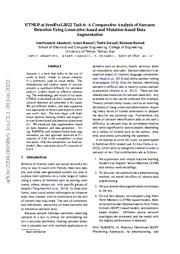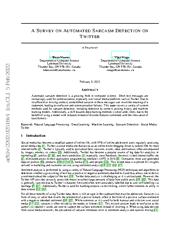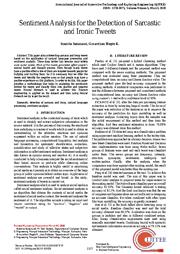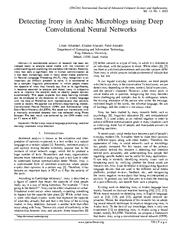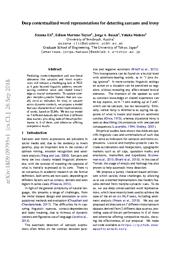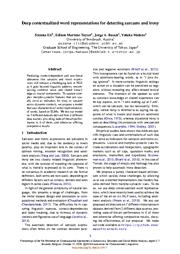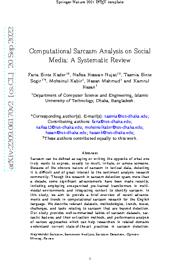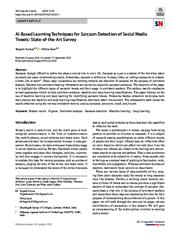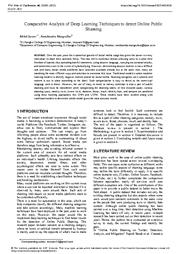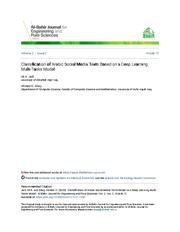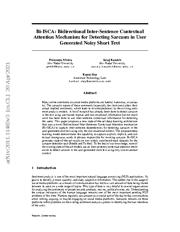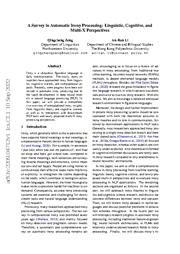A copy of this work was available on the public web and has been preserved in the Wayback Machine. The capture dates from 2020; you can also visit the original URL.
The file type is application/pdf.
Filters
Indonesian Sarcasm Detection Using Convolutional Neural Network
2020
International Journal of Emerging Trends in Engineering Research
To solve this potential problem, the detection of sarcasm is necessary. A convolutional neural network model is used in this paper to handle the automated identification of sarcasm in Indonesian. ...
This fact can be seen by the lack of publications on Indonesian sarcasm detection studies. This study is conducted to contribute to other Indonesian sarcasm detection studies. ...
While [3] proposed a context augmented neural network model for twitter sarcasm detection. ...
doi:10.30534/ijeter/2020/10892020
fatcat:2d6wx4vlqrghtc2tkbrxfir6ui
Word similarity score as augmented feature in sarcasm detection using deep learning
2018
International Journal of Advanced Computer Research
Recent researches incorporate machine learning and deep learning methods to detect sarcasm. Sarcasm can be detected by the occurrence of context disparity. ...
Sarcasm detection is an important task in natural language processing (NLP). Sarcasm flips the polarity of a sentence and will affect the accuracy of sentiment analysis task. ...
Acknowledgment We thank you Binus University AI Research Center for the computing facility.
Conflicts of interest The authors have no conflicts of interest to declare. ...
doi:10.19101/ijacr.2018.839002
fatcat:35paajskr5a3pnchl7kha3iqbm
UTNLP at SemEval-2022 Task 6: A Comparative Analysis of Sarcasm Detection Using Generative-based and Mutation-based Data Augmentation
[article]
2022
arXiv
pre-print
The methodology and results of our team, UTNLP, in the SemEval-2022 shared task 6 on sarcasm detection are presented in this paper. ...
The metaphorical and creative nature of sarcasm presents a significant difficulty for sentiment analysis systems based on affective computing. ...
Furthermore, we combined LSTM and BLSTM with Convolutional Neural Networks (CNNs). ...
arXiv:2204.08198v5
fatcat:rwly2zrkfbdfriuzhnsqwiwjpe
A Survey on Automated Sarcasm Detection on Twitter
[article]
2022
arXiv
pre-print
This paper covers a variety of current methods used for sarcasm detection, including detection by context, posting history and machine learning models. ...
Automatic sarcasm detection is a growing field in computer science. Short text messages are increasingly used for communication, especially over social media platforms such as Twitter. ...
Additionally, special thanks to Abhigya Koirala for his time creating charts and diagrams for use in this work and to Manmeet Kaur Baxi for her Twitter expertise. ...
arXiv:2202.02516v1
fatcat:wqweisnkxrfmliglvoyryhkkle
Sentiment Analysis for the Detection of Sarcastic and Ironic Tweets
2020
VOLUME-8 ISSUE-10, AUGUST 2019, REGULAR ISSUE
This paper aims at detecting sarcasm and irony tweets based on the application of natural language processing and sentiment analysis. These days twitter has become most widely used social media. ...
Neural Network is used to achieve this. Feature engineering is applied on the dataset and then using Neural Network we try to get the result. ...
First one is neural model using context augmentation by integrating key contextual information (CANN KEY) and second one is neural model using context augmentation by integrating all contextual information ...
doi:10.35940/ijitee.b6359.039520
fatcat:mxfqeloazzba7j2okzrbdedete
Detecting Irony in Arabic Microblogs using Deep Convolutional Neural Networks
2022
International Journal of Advanced Computer Science and Applications
We applied two different deep learning models; Convolutional Neural Network (CNN) and Bidirectional Long Short-Term Memory (BiLSTM). ...
Due to its significance, it becomes essential to analyze and detect irony in subjective texts to improve the analysis tools to classify people opinion automatically. ...
[23] employed two context-augmented neural network methods on Twitter dataset to recognize sarcastic signs from contextual data. Baruah et al. ...
doi:10.14569/ijacsa.2022.0130187
fatcat:4xyn7ejmfjauzcldr4vlg2lm4y
Deep contextualized word representations for detecting sarcasm and irony
[article]
2018
arXiv
pre-print
To capture complex morpho-syntactic features that can usually serve as indicators for irony or sarcasm across dynamic contexts, we propose a model that uses character-level vector representations of words ...
Predicting context-dependent and non-literal utterances like sarcastic and ironic expressions still remains a challenging task in NLP, as it goes beyond linguistic patterns, encompassing common sense and ...
On the other hand, deep models for irony and sarcasm detection, which are currently offer stateof-the-art performance, have exploited sequential neural networks such as LSTMs and GRUs (Veale, 2016; Zhang ...
arXiv:1809.09795v1
fatcat:tby44ccwkrfw3ae3zme5nwyjky
Deep contextualized word representations for detecting sarcasm and irony
2018
Proceedings of the 9th Workshop on Computational Approaches to Subjectivity, Sentiment and Social Media Analysis
To capture complex morpho-syntactic features that can usually serve as indicators for irony or sarcasm across dynamic contexts, we propose a model that uses character-level vector representations of words ...
Predicting context-dependent and non-literal utterances like sarcastic and ironic expressions still remains a challenging task in NLP, as it goes beyond linguistic patterns, encompassing common sense and ...
On the other hand, deep models for irony and sarcasm detection, which are currently offer stateof-the-art performance, have exploited sequential neural networks such as LSTMs and GRUs (Veale, 2016; Zhang ...
doi:10.18653/v1/w18-6202
dblp:conf/wassa/IlicMBM18
fatcat:dyac66m3pfcelfyhtweig56qdq
Computational Sarcasm Analysis on Social Media: A Systematic Review
[article]
2022
arXiv
pre-print
and integrating context to identify sarcasm. ...
In this study, we aim to provide a brief overview of recent advancements and trends in computational sarcasm research for the English language. ...
[123] is the first to propose an Affective Dependency Graph Convolutional Network (ADGCN) framework for sarcasm detection. ...
arXiv:2209.06170v2
fatcat:2yspcvkbwfhozddw43w4r763ci
AI-Based Learning Techniques for Sarcasm Detection of Social Media Tweets: State-of-the-Art Survey
2020
SN Computer Science
These days' researchers are working towards the detection of sarcasm for the purpose of sentiment analysis. Emotion and sentiment-bearing information are carried by subjective sarcastic sentences. ...
The paper focuses on the use of machine learning and deep learning for identifying sarcastic tweets. ...
Role of Deep Learning Neural Network for the Identification of Sarcasm The target of attention for these days is semantic modeling that uses neural networks [10] for social media. ...
doi:10.1007/s42979-020-00336-3
fatcat:77ax2mw4grcvlgo4n7i5t5knka
Comparative Analysis of Deep Learning Techniques to detect Online Public Shaming
2021
ITM Web of Conferences
Such categorization is easy to detect as the contextual language used is direct. ...
In this research paper, various shaming types, namely toxic, severe toxic, obscene, threat, insult, identity hate, and sarcasm are predicted using deep learning approaches like CNN and LSTM. ...
[2] uses deep convolution neural networks. They have a deep understanding and study of emotions as well as sentiments for the detection of sarcasm. ...
doi:10.1051/itmconf/20214003030
fatcat:dguymrkme5fkhpudh67buqrxye
Classification of Arabic Social Media Texts Based on a Deep Learning Multi-Tasks Model
2023
Al-Bahir Journal for Engineering and Pure Sciences
In this context, the system solves many tasks in natural language processing therefore it uses many techniques including topic classifier, sentiment analyzer, sarcasm detector and emotion classifier. ...
CNN-BiLSTM was used for topic classifier, sentiment analyzer, sarcasm detector, and emotion classifier where (f-measure, accuracy) were (97,97.58) %, (84,86) %, (95,97) %, and (82,81.6) % respectively. ...
Acknowledgements The author expresses gratitude to the IT staff at the University of AlKafeel for their valuable support in providing the necessary instrumentation facilities to conduct this work. ...
doi:10.55810/2312-5721.1030
fatcat:mor6andmufcpjpv224yhe6y5i4
Bi-ISCA: Bidirectional Inter-Sentence Contextual Attention Mechanism for Detecting Sarcasm in User Generated Noisy Short Text
[article]
2021
arXiv
pre-print
Bi-ISCA generates state-of-the-art results on two widely used benchmark datasets for the sarcasm detection task (Reddit and Twitter). ...
detecting sarcasm in the user-generated short text using only the conversational context. ...
In this paper, we propose a novel Bidirectional Inter-Sentence Contextual Attention mechanism (Bi-ISCA) based deep learning neural network for sarcasm detection. ...
arXiv:2011.11465v3
fatcat:gi7oqqztg5ewveu53ptmnuveue
Cross Domain Hybrid Feature Fusion based Sarcastic Opinion Recognition Over E-Commerce Reviews Using Adversarial Transfer Learning
2023
International Journal of Intelligent Engineering and Systems
The hybrid features are used for sarcasm detection in two combinations. ...
Sarcasm detection is a challenge in review based e-commerce product recommendation systems. ...
Jamil et al [12] proposed a hybrid approach for sarcasm detection for multi domain datasets. Convolutional neural network (CNN) is used for feature extraction. ...
doi:10.22266/ijies2023.0430.13
fatcat:vidgfpkgdrbi7cv7ypugzbd5me
A Survey in Automatic Irony Processing: Linguistic, Cognitive, and Multi-X Perspectives
[article]
2022
arXiv
pre-print
Recently, some progress have been witnessed in automatic irony processing due to the rapid development in deep neural models in natural language processing (NLP). ...
Yat Mei Lee for their suggestions. ...
Supervised Neural Network Era There have been irony detection tasks in various languages after 2015, among which most participants used convolutional neural networks (CNNs) and RNNs methods to detect ironical ...
arXiv:2209.04712v1
fatcat:bekt7vqbzfgvdeovtotdsh6qke
« Previous
Showing results 1 — 15 out of 275 results


